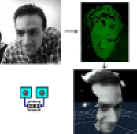

 |
|
Feature Comparison Chart
|
Feature |
Calibration |
Rectification | Correlation | Speed 320x240, 32 disparities Intel Celeron 600 MHz |
Sub-pixel interpolation |
Post-filter | 3D transform |
| SVS | User
calibration Any binocular stereo hardware |
Yes | SAD | 59.3 ms /
frame 16.8 frames / second |
1/16 pixel | Texture, Left/Right Check | Yes |
| Pt Grey | Factory set Pt Grey trinocular hardware only |
Yes | SAD | 394.7 ms /
frame 2.5 frames / second |
1/256 pixel | Texture, Peak Threshold |
Yes |
Notes: